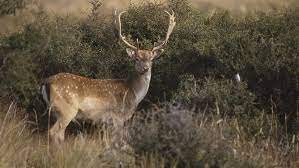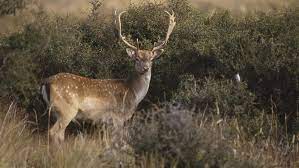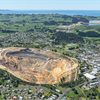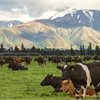Forest & Bird has created a series of maps from official data, showing virtually all conservation land on mainland New Zealand, and massive areas of privately owned land, are under attack from herds of wild deer, pigs, and goats.
Forest & Bird is calling for the government’s climate plan to urgently fund the largest deer, pig, and goat control programme New Zealand has ever seen to maintain important carbon sinks and the ecological health of native forests.
“The number and extent of wild deer, pigs, and goats on all land types across New Zealand is at crisis levels,” says Forest & Bird Chief Executive Kevin Hague.
"Our analysis shows that close to 100% of native habitat has at least one species of deer, pig or goat on it, while two thirds of primary production land is under invasion from these animals.
“Our maps hint at the true scale of the problem, but we know it’s much worse than that. The empty forest understories, lack of regeneration, and destroyed new plantings we’re seeing show that not only have these pests spread further, there are also far more of them than there were before,” says Mr Hague.
Regeneration of palatable tree species has almost entirely stopped in many forests, as the increasing number of browsing animal herds destroy young trees and undergrowth, eating young forests before they have a chance to grow.
The maps show how extensively deer, pigs and goats have spread, and that vast tracts of conservation land are being hammered by multiple browsing species. Forest & Bird says their maps show Port Waikato, Whanganui, East Cape, Marlborough, Central Otago, Kaikoura Ranges, and the Catlins are especially under pressure from four or more species of deer, pigs, and goats.
“Without regeneration occurring, the outcome will be a disaster for the country's native habitat, the species that live there, and our climate,” says Mr Hague.
These pests are also spilling onto massive swathes of farm, forestry, and privately owned conservation reserves. New Zealand’s largest farmer, Pâmu, is working to contain the problem, but says it is a tough battle and extremely expensive.
Gordon Williams, Pâmu’s environment manager for its forestry operations, says the number of pests it sees across its farm portfolio is increasing.
“We have established forestry and erosion control and riparian plantings on our East Coast and northern Hawke’s Bay farms and began pest control to give the plantings the best chance of survival, but the numbers of pests, particularly goats and deer, are making this very challenging.
“Even our farm staff were unaware of the scale of the problem, and we are likely underestimating the pests within the wider landscape. It is an ever-growing threat to our work establishing plantings for forestry, but also for erosion and nitrogen leaching control.
“We have initiated full-scale pest and predator control on every one of our Northland farms covering nearly 18,000 hectares, which has seen a marked decrease in the destructive effects of pigs and other pests, but has come at considerable financial cost,” Mr Williams said.
Native forests have been recognised by the Climate Change Commission as nationally-significant carbon sinks that are vital to climate protection efforts. The Commission has called for a massive forest restoration programme alongside a ramped-up browsing pest control programme to protect all existing native forests.
“Unless there is urgent intervention, our country’s largest living carbon sinks are on a death watch,” says Mr Hague. “But saving our forests is going to take a multi-agency approach as part of New Zealand’s climate efforts.
“This is extremely important. New Zealand’s ancient native forests are central to helping us do our fair share and keeping warming to safe levels – our future relies on the health of native forests, along with the future of the native birds, insect and plants that call those forests home.
“Right now the government is asking for submissions on its Emissions Reduction Plan consultation. We’re inviting all New Zealanders to make a
submission and join us in telling the government that protecting native forests needs to be a priority for protecting the climate.”
Notes:
Forest & Bird’s analysis shows that:
– 95.7% of DOC conservation land includes at least one ungulate species. DOC PCA excludes Marine Reserves, Wildlife Areas and Marginal Strips (because they are so narrow it distorts the stats). As DOC PCA definition includes offshore islands, lakes/estuaries, and snow it is most probable that 100% of habitable DOC land on mainland New Zealand has ungulates (with the exception of a few offshore islands where they never existed or have been eradicated).
– 96.8% of indigenous vegetation, regardless of land ownership, has one or more ungulate species present. Of 11,485,903 ha. of indigenous vegetation land, 11,119,627 hectares has one or more ungulate species. The areas without are offshore islands, army training area at Tekapo, and scattered areas of Northland where ungulates are not common.
– 66.8% of primary production land has one or more ungulate species. Of 12,984,285 ha. of primary production land, 8,674,627 hectares has one or more ungulate species. The areas without are high producing area such as dairy, and a large chunk of Northland where ungulates are not common.
Eleven species of deer, pigs and goats have been introduced to New Zealand since the arrival of Europeans. In the South Island, there are three goat species – including two mountain goats, four deer species, and pigs. In the North Island there are five deer species, as well as feral goats and pigs.
Native plants have not evolved to cope with browsing mammals. It's uncommon for them to have the toxic or thorny defenses that plants overseas might have to discourage introduced toothed mammals. Instead native plants make a delicious snack and are easy pickings for deer, pigs and goats.
Maps
Deer Pig and Goat presence (2007/2014 data) and density (2019 data). Key indicates areas which areas have highest densities of ungulates.
Heat Map Number of Species: (2007/2014 data)












